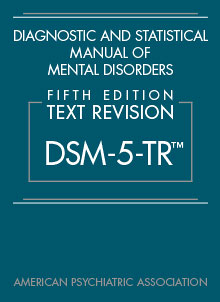Updated DSM-5 Text Revisions to Be Released in March
Abstract
With contributions from more than 200 subject matter experts, the updated volume boasts the most current text updates based on the scientific literature.

Significant changes—including the addition of prolonged grief disorder and the inclusion of symptom codes for suicidal behavior and nonsuicidal self-injury, refinement of criteria, and comprehensive literature-based updates to the text—will appear in the Diagnostic and Statistical Manual of Mental Disorders, Fifth Edition, Text Revision (DSM-5-TR), to be released by American Psychiatric Association Publishing in March.
Michael B. First, M.D., co-chair of the Revision Subcommittee and DSM-5-TR editor, said the revised manual includes updates that are vital to clinicians and researchers. These include clarifying modifications to the criteria sets for more than 70 disorders, updates to descriptive text for the majority of disorders based on literature reviews, and a comprehensive review of the impact of racism and discrimination on the diagnosis and manifestations of mental disorders.
“DSM is widely regarded as the most authoritative source of information about most aspects of mental disorders except treatment,” First told Psychiatric News. “This information, encapsulated in the DSM text, is continually evolving. Consequently, it is crucial for the text to be kept up to date based on evolving psychiatric literature. DSM-5 text sections on ‘Risk and Prognostic Factors’ and ‘Diagnostic Markers’ contain information more susceptible to becoming outdated on the basis of scientific advances. Nine years have elapsed since publication of DSM-5 in 2013, longer than historical revisions to DSM after five to seven years.”
Most noteworthy is the addition of a new disorder, prolonged grief disorder. First said the addition is the result of years of research and clinical experience indicating that some people experience a pervasive inability to move past grief over the loss of a loved one and that these symptoms are severe enough to affect day-to-day functioning. It is estimated that following the nonviolent loss of a loved one, 1 in 10 bereaved adults is at risk for developing prolonged grief disorder, he said. (See box below for the criteria for prolonged grief disorder.)
Preorder Your DSM-5-TR, Related Titles Now
DSM-5-TR and a number of related titles will be available in March and can be preordered here. The related titles are Desk Reference to the Diagnostic Criteria From DSM-5-TR, The Pocket Guide to the DSM-5-TR Diagnostic Exam, DSM-5-TR Repositionable Page Markers, and DSM-5-TR Classification. APA members receive a 20% discount, and resident-fellow members receive a 25% discount.
The DSM-5-TR app will be available in the fall.
Additionally, DSM-5-TR includes new symptom codes that allow clinicians to indicate the presence or history of suicidal behavior and nonsuicidal self-injury.
The suicidal behavior and nonsuicidal self-injury codes appear in the Section II chapter “Other Conditions That May Be a Focus of Clinical Attention.” This chapter features conditions and problems that are not mental disorders in themselves, but for which it is useful to have a systematic way of recording—for researchers, because it can help them track prevalence and correlates, and for clinicians, because these conditions may warrant ongoing clinical attention.

Michael B. First, M.D., co-chair of the Revision Subcommittee and DSM-5-TR editor, says nine years have elapsed since publication of DSM-5, necessitating the development of a revised edition that will be invaluable to clinicians.
The suicidal behavior symptom code can be used for individuals who have engaged in potentially self-injurious behavior with at least some intent to die as a result of the act. Evidence of intent to end their life can be explicit or inferred from the behavior or circumstances. A suicide attempt may or may not result in actual self-injury.
The nonsuicidal self-injury symptom code can be used for individuals who have engaged in intentional self-inflicted damage to their body that is likely to induce bleeding, bruising, or pain (for instance, by cutting, burning, stabbing, hitting, or excessive rubbing) in the absence of suicidal intent.
Additionally, the category “Unspecified Mood Disorder” was restored in DSM-5-TR for mixed mood presentations that do not meet criteria for a bipolar or depressive disorder. The absence of unspecified mood disorder from DSM-5 was an unintentional byproduct of the decision to eliminate the mood disorders diagnostic class from DSM-5 in favor of making bipolar disorders and depressive disorders top-level diagnostic classes.
DSM-5-TR also includes updates to terminology and nomenclature. The term “neuroleptic,” as applied to a class of medication, is an anachronistic term that emphasizes side effects. It will no longer be used except in the case of the widely used “neuroleptic malignant syndrome.”
The terms with which it is being replaced depend on the context in which “neuroleptic” had been used. “Antipsychotic medication” is used when referring to the treatment of psychotic symptoms, and “antipsychotic medication or other dopamine receptor blocking agent” is used when referring to the broader pharmacological class, usually in the context of side effects such as tardive dyskinesia.
There have also been significant updates to the terminology to describe gender dysphoria. The term “desired gender” is now “experienced gender,” the term “cross-sex medical procedure” is now “gender-affirming medical procedure,” and the term “natal male”/“natal female” is now “individual assigned male/female at birth.”
Diagnostic criteria have been revised for several disorders, primarily for clarification. These include changes in the criteria sets for the following diagnoses:
Autism spectrum disorder
Manic episode
Bipolar I and bipolar II disorder
Cyclothymic disorder
Major depressive disorder
Persistent depressive disorder
PTSD in children
Avoidant-restrictive food intake disorder
Delirium
Substance/medication-induced mental disorders
Attenuated psychosis syndrome (in the chapter “Conditions for Further Study”)
Additionally, there are changes to the specifier definitions for several disorders. These include changes to the severity specifiers for manic episode, the mood congruent/mood incongruent specifier for bipolar disorder, the mixed features specifier for major depressive disorder, the acute/persistent specifier for adjustment disorder, narcolepsy specifiers, and the post-transition specifier for gender dysphoria.
Two disorders have been renamed to adopt current usage: Intellectual disability is now intellectual developmental disorder, and conversion disorder is now functional neurological symptom disorder.
Codes and coding notes have been updated for substance use and neurocognitive disorders, and coding updates have been made throughout the book to capture all changes since DSM-5’s publication in 2013. The opening Section I chapters, “Introduction” and “Use of the Manual,” have been extensively revised to include new sections that will enhance context and use by new and seasoned clinicians.
Finally, most disorder texts were updated, with about three-quarters having significant revisions. Text sections most extensively updated are “Prevalence,” “Risk and Prognostic Factors,” “Culture-Related Diagnostic Features,” “Sex- and Gender-Related Diagnostic Features,” “Association With Suicidal Thoughts or Behavior,” and “Comorbidity.”
“APA and American Psychiatric Association Publishing are proud to offer DSM-5-TR as an essential reference for all mental health professionals,” said APA CEO and Medical Director Levin, M.D., M.P.A. “The updated manual reflects evolving research and clinical experience and will be of enormous benefit to practitioners, researchers, academic institutions, and health systems.” ■
Diagnostic Criteria for Prolonged Grief Disorder (F43.8)
The death, at least 12 months ago, of a person who was close to the bereaved individual (for children and adolescents, at least 6 months ago).
Since the death, the development of a persistent grief response characterized by one or both of the following symptoms, which have been present most days to a clinically significant degree. In addition, the symptom(s) has occurred nearly every day for at least the last month:
Intense yearning/longing for the deceased person.
Preoccupation with thoughts or memories of the deceased person (in children and adolescents, preoccupation may focus on the circumstances of the death).
Since the death, at least three of the following symptoms have been present most days to a clinically significant degree. In addition, the symptoms have occurred nearly every day for at least the last month:
Identity disruption (e.g., feeling as though part of oneself has died) since the death.
Marked sense of disbelief about the death.
Avoidance of reminders that the person is dead (in children and adolescents, may be characterized by efforts to avoid reminders).
Intense emotional pain (e.g., anger, bitterness, sorrow) related to the death.
Difficulty reintegrating into one’s relationships and activities after the death (e.g., problems engaging with friends, pursuing interests, or planning for the future).
Emotional numbness (absence or marked reduction of emotional experience) as a result of the death.
Feeling that life is meaningless as a result of the death.
Intense loneliness as a result of the death.
The disturbance causes clinically significant distress or impairment in social, occupational, or other important areas of functioning.
The duration and severity of the bereavement reaction clearly exceed expected social, cultural, or religious norms for the individual’s culture and context.
The symptoms are not better explained by another mental disorder, such as major depressive disorder or posttraumatic stress disorder, and are not attributable to the physiological effects of a substance (e.g., medication, alcohol) or another medical condition.



